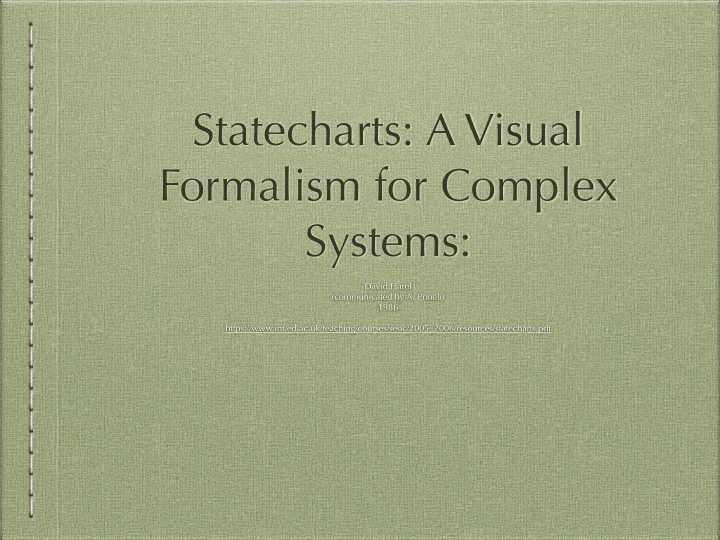

Statecharts: A Visual Formalism for Complex Systems: David Harel (communicated by A. Pnueli) 1986 https://www.inf.ed.ac.uk/teaching/courses/seoc/2005_2006/resources/statecharts.pdf
About me: EE (PEng) 8T1 Also, studied in Core Physics (7T9) Compilers, OSs, DSLs, embedded systems. Ran s/w consultancy 25+ years I first read Harel’s paper in 1987, then applied it to Injection Molding machines project, to replace PLCs. Current Interests: Diagrams-as-Syntax Expression of design intent, Software Dev —> Engineering + guarantees.
STATECHARTS: A VISUL FORMALISM FOR COMPLEX SYSTEMS 44 pages - 49 figures - Hierarchy - Concurrency - Communication - Structured control flow - - 9 sections (meat of notation in sections 2-5)
The notation was used originally for avionics (closed source). This paper describes a Citizen Digital Watch as its demo. The Digital Watch is reverse-engineered, and the diagrams indicate that the watch was “designed by committee”
1. Introduction
Simple State Diagram A/B/C are States alpha/beta/delta/gamma are Events P is a guard predicate
2. State-levels: Clustering and Refinement
Clustering A & C moved inside D All beta transitions combined into a single transition Children of D (A/C) cannot override parent’s beta transition (opposite of inheritance)
Different views of same states
- Running example (Citizen Quartz Multi-Alarm III watch)
Default Entry Point (i) Enter A by default (ii) Enter D.A by default (iii) Enter D by default, then Enter A by default (in D)
State Explosion “any button pressed” is 3 arrows “30 sec in alarms-beep” is 3 arrows Both compressed to 1 arrow (each) through clustering.
Enter ‘time’ by default When in ‘time’ { if “d” is pressed, goto ‘date’ if “a” is pressed, goto ‘alarm1’ } When in ‘alarm1’, 4 more “a” presses will goto ‘time’ When in ‘date’, 1 more “d” press, or 2 minutes, will goto ‘time’
History (a) 1-level “history” chooses K.G or K.F (i.e. K.G.B or K.F.C) (b) “deep history” uses most recent states (K.G.A or K.G.B or K.F.C or K.F.D or K.F.E)
Underspecified? c can be held down during update can b be pressed while c down? Time Delay Edge-driven or value driven? “c PUSHED down” vs. “c IS down”. Is c-up ignored in ‘update’ / ‘time’? time —>on c down—> wait (see semantics paper) wait —>on c up—>time Observation: Diagrams make some wait —>on 2 sec—>update semantic questions easier to spot.
Economical Representation Paper states that (c) is a contradiction ((a) with arrows reversed is a contradiction)
Two Contradictions Exit A on event alpha 1. 2. Enter B on beta C is underspecified (no default)
3. Orthogonality: Independence and concurrency
Two Simultaneous States Default state is Y.A.B ^ Y.D.F Transition from Y.A.C to Y.A.B guarded by predicate “(in G)”
Fig. 20 is the AND-free equivalent of Fig. 19
Top down specification of watch
Pattern for solving race condition “b” and “d” pressed “simultaneously”. Which is seen first? This pattern sorts the problem out.
Full Diagram for Digital Watch N.B. ‘beep-test’ is valid in ‘date/time/update’, but not in ‘wait’ - hence, notch in ‘regular’ N.B. Citizen Documentation claims that ‘beep-test’ and ‘light’ work the same, yet author found differences.
4. Additional Statechart Features Features that were not shown in Watch example Conditional - Selection - Timeout - Unclustering -
5. Actions and activities
Entry & Exit Code In state C, event alpha will cause execution of “entry S”, “throughout X” and “entry V” And B->F will not cause S to be eval’ed again
6. Possible Extensions to the formalism Parameterized states - Overlapping states - D.R.Y. - Incorporating temporal logic - Recursive states - Probabilistic states -
7. Semantics of statecharts Broadcast Micro-steps See [15]
8. Related Work - state explosion problem SDL - not hierarchical - ATNs - Petri nets - CCS - CSP - ESTEREL - Sequence Diagrams -
9. Practical experience and implementation (dated?) STATEMATE1 I-Logix IBM Rational UML 2
My Experience + It is easy to compile diagrams. Glyphs == {rect, arrow, text, dot}. Inference (Prolog, minikanren?, pattern-matching?) derives all other properties. Only compiled code (diagrams) is meaningful, Comments don’t work. Compilation. (Modeling is not compilation). Errors are not special. Errors are events. (No need for throw/catch). ++ Notation is understandable by “management” (kind-of Agile?) Structured control of state. (=> structuring other aspects, like spaghetti message-passing) + Code uses glyphs not pixels, e.g. a-z, A-Z, 0-9 etc. ++ See also DRAKON + Glyphs, not pixels, are used in text languages - a-z,A-Z,0-9 etc. +
My Experience (con’t) Concurrency can be lifted to another notation. Other resources (recently discovered): https:/statecharts.github.io w3.org/TR/scxml/ (http://drakon-editor.sourceforge.net/)
paultarvydas@gmail.com https://github.com/guitarvydas
Recommend
More recommend